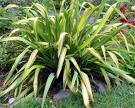Flax
Linum usitatissimum Linaceae Also called Linseed The slender, graciful flax is a herbaceous annual that is cropped throughout Europe. Its seeds, known as linseed, are widely used in herbal medicine and yield a valuable oil; the fibres if its stalks are used to make linen. Flax grows to about 1 m in height and bears beautiful sky-blue flowers. The pea-sized fruits contain ten oily seeds. Parts used
PREPARATION AND DOSAGEFor internal use TO TREAT chronic (long-term) constipation, disorders of the colon, inflammation of the gastric and intestinal mucous membranes. MACERATION Put 15-20g of seeds into 1 litre of cold water. leave to soak overnight and strain. Drink 1 glass in the morning before eating and then 4-5 glasses during the day, but not at mealtimes. WHOLE SEEDS Take 15-20 seeds with a glass of water three times a day. For external use TO TREAT spots and boils, itching, bruising, painful joints POULTICE Slowly pour water onto flax meal stirring all the while until it has become a smooth paste. Warm this gently and spread it, still slightly warm, in a layer about 1cm thick onto a piece of gauze. Apply to the affected part one to three times a day. IF SYMPTOMS PERSIST CONSULT A DOCTOR ConstituentsThe seed is made up of 35-45 per cent oil. linseed oil is rich in omega-3 unsaturated fatty acids which protect against heart and circulation problems and are antiinflammatory. The seed also contains proteins, mucilage, cholesterollowering phytosterols, anti-inflammatory lignans and cyanogenic glycosides which are antispasmodic. Medicinal usesFlax seed is a gentle laxative. It is used to treat long-term constipation and colon disorders. It contains mucilage that lines and soothes the mucous membranes of an irritated digestive system and painful bowel. The phytoestrogens in the seeds appear to have a beneficial effect on some breast and colon cancers. And a paper published in the American Journal of Kidney Disease in 2001 reported linseed's potential in the treatment of kidney disorders. US research in New Jersey, in 1993 showed that flax seed reduced blood cholesterol in patients with high blood cholesterol levels. And an American paper published in 2000 suggested the seeds might benefit people with atherosclerosis. Flax meal has long been used externally as a poultice for skin disorders such as spots and boils, itching, ulcers and bruising. It also helps to soothe painful joints. CultivationSow seeds in spring in well-drained soil in a sunny location. CAUTIONS
|
Ayurveda Book
This book on Ayurveda is meant for people interested to know about basics concepts of Ayurvedic healing and learn ayurveda concepts. Though there are many books Read More My SitesReal Testimonials
Connect with us |







